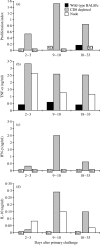Depletion of CD8+ cells abolishes memory in acquired immunity against Chlamydia pneumoniae in BALB/c mice
- PMID: 10447772
- PMCID: PMC2326855
- DOI: 10.1046/j.1365-2567.1999.00809.x
Depletion of CD8+ cells abolishes memory in acquired immunity against Chlamydia pneumoniae in BALB/c mice
Abstract
The importance of T cells in Chlamydia pneumoniae infection in mice was assessed by comparing wild-type BALB/c mice with nude mice and mice depleted in vivo of either CD4+ or CD8+ T cells. Whereas wild-type mice cleared the primary infection in 3 weeks, nude mice were only able to restrict the infection and could not clear it during the observation period of 56 days. Nude mice exhibited a greater number of macrophages in their lungs and the pulmonary cells secreted a higher level of tumour necrosis factor-alpha (TNF-alpha) than wild-type mice. Depletion of CD4+ cells did not change the overall infection kinetics of the primary infection. However, depletion of CD8+ cells resulted in a slightly impaired clearance of the bacteria in the late stages of primary infection. To assess the role of the two T-cell subsets in the acquired immunity that develops during primary infection in wild-type BALB/c mice, in vivo depletions were performed during reinfection. Prior to reinfection, immunocompetent wild-type mice were infected and natural immunity was allowed to form. During reinfection, depletion of CD4+ cells did not have any effect on infection kinetics, whereas depletion of CD8+ cells abolished the protection, reverting the infection kinetics and bacterial load to the same levels found in wild-type mice during primary infection. These results show that T cells are necessary for clearing C. pneumoniae infection in mice. Furthermore, whereas neither of the two main T-cell subsets, separately, were essential for clearance of primary infection, the induced protective immunity was strongly CD8 dependent.
Figures



Similar articles
-
Role of innate and adaptive immunity in the outcome of primary infection with Chlamydia pneumoniae, as analyzed in genetically modified mice.J Immunol. 1999 Mar 1;162(5):2829-36. J Immunol. 1999. PMID: 10072530
-
Macrophages, CD4+ or CD8+ cells are each sufficient for protection against Chlamydia pneumoniae infection through their ability to secrete IFN-gamma.J Immunol. 2004 Feb 15;172(4):2407-15. doi: 10.4049/jimmunol.172.4.2407. J Immunol. 2004. PMID: 14764711
-
Role of CD8 T cells in primary Chlamydia infection.Infect Immun. 1995 Feb;63(2):516-21. doi: 10.1128/iai.63.2.516-521.1995. Infect Immun. 1995. PMID: 7822016 Free PMC article.
-
Cell mediated immunity to Chlamydia pneumoniae.Scand J Infect Dis Suppl. 1997;104:18-21. Scand J Infect Dis Suppl. 1997. PMID: 9259075 Review.
-
Role of CD8(+)T cells in the host response to Chlamydia.Microbes Infect. 2008 Nov-Dec;10(14-15):1420-30. doi: 10.1016/j.micinf.2008.08.006. Epub 2008 Aug 26. Microbes Infect. 2008. PMID: 18790073 Free PMC article. Review.
Cited by
-
Dendritic cells from aged subjects display enhanced inflammatory responses to Chlamydophila pneumoniae.Mediators Inflamm. 2014;2014:436438. doi: 10.1155/2014/436438. Epub 2014 Sep 1. Mediators Inflamm. 2014. PMID: 25253920 Free PMC article.
-
Identification of Chlamydia pneumoniae-derived mouse CD8 epitopes.Infect Immun. 2002 Jul;70(7):3336-43. doi: 10.1128/IAI.70.7.3336-3343.2002. Infect Immun. 2002. PMID: 12065471 Free PMC article.
-
Acquired immunity to Chlamydia pneumoniae is dependent on gamma interferon in two mouse strains that initially differ in this respect after primary challenge.Infect Immun. 2000 Feb;68(2):960-4. doi: 10.1128/IAI.68.2.960-964.2000. Infect Immun. 2000. PMID: 10639472 Free PMC article.
-
CD4+ T cells mediate antibody-independent acquired immunity to pneumococcal colonization.Proc Natl Acad Sci U S A. 2005 Mar 29;102(13):4848-53. doi: 10.1073/pnas.0501254102. Epub 2005 Mar 21. Proc Natl Acad Sci U S A. 2005. PMID: 15781870 Free PMC article.
-
Filamin A editing in myeloid cells reduces intestinal inflammation and protects from colitis.J Exp Med. 2025 Sep 1;222(9):e20240109. doi: 10.1084/jem.20240109. Epub 2025 Jun 5. J Exp Med. 2025. PMID: 40471139 Free PMC article.
References
-
- Danesh J, Collins R, Peto R. Chronic infections and coronary heart disease: is there a link? Lancet. 1997;350:430. - PubMed
-
- Ward ME. The immunobiology and immunopathology of chlamydial infections. APMIS. 1995;103:769. - PubMed
-
- Cotter TW, Byrne GI. Immunity to Chlamydia: comparison of human infections and murine models. Res Immunol. 1996;147:587. - PubMed
Publication types
MeSH terms
Substances
LinkOut - more resources
Full Text Sources
Other Literature Sources
Medical
Molecular Biology Databases
Research Materials

